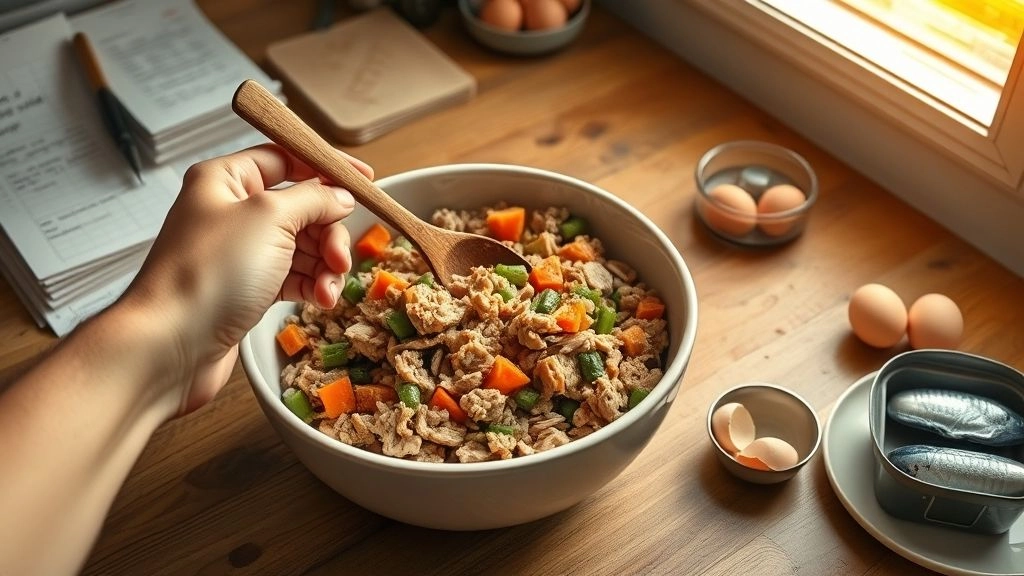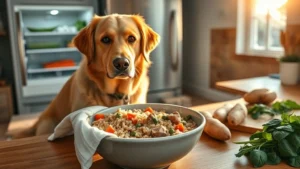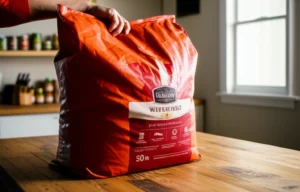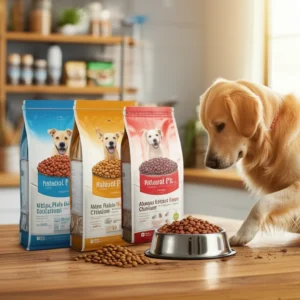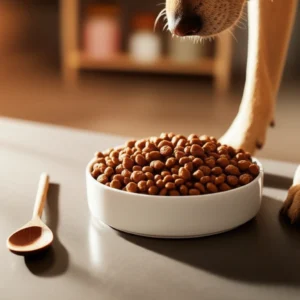Why Bother With Homemade?
Let’s skip the “homemade vs. store-bought” lecture and get real: have you ever stood in the pet food aisle, staring at bags priced like they’re caviar, and thought—wait, don’t dogs literally eat dirt sometimes? (Mine once ate part of a plastic spoon. Don’t ask.) Anyway, it kinda stings to drop serious cash on mystery nuggets, especially when you peek at the ingredients and half of them sound like failed science experiments.
But here’s the best part: making homemade dog food can actually be way cheaper—if you do it right. Plus, you control what goes in. No weird fillers, no “chicken by-product meal.” Just real stuff you’d actually recognize. If budget is tight (and honestly, isn’t it always?), this is a secret weapon. Money-saving, simple, and—bonus—you look like a pet care genius.
I started this whole DIY-dog-cuisine thing as a last-ditch effort after my dog’s allergic reactions kicked our vet bills through the roof. I figured, hey, even I can cook rice and chuck in some veggies… right? Spoiler: It worked. My wallet recovered, and my dog started acting like a puppy again. Here’s what I’ve learned (the easy way and the hard way).
Budget Protein Picks
What’s the Base of Every Good Recipe?
You know how we all sort of default to “chicken and rice” at least once a week when our own budgets feel tight? Dogs kinda appreciate that same comfort. For most Best homemade dog food recipes for small dogs (yep, there’s your related keyword), the backbone is protein, and not the fancy kind.
Stick with lean ground turkey, chicken breast (boneless, skinless), or lean beef. Whatever’s on sale, or that giant 5-lb family pack that always pops up at the end of the aisle. Ground turkey is my go-to—it’s cheap, mild, and dogs basically inhale it.
Table: Budget Protein Ideas
| Protein | Cost Saver | Why Dogs Love It |
|---|---|---|
| Ground turkey | Bulk packs, usually the cheapest | Easy to digest, mild taste |
| Chicken breast | Watch for “manager’s special” sales | Low in fat, high in protein |
| Eggs | The ultimate budget protein, buy by the dozen | Boosts coat shine, extra nutrients* |
*Bonus hack: Scramble a few eggs—shells and all—for calcium (just be sure to grind them fine if you use the shells).
I’ve literally survived tight months by batch-cooking ground turkey from the discount bin mixed with whatever veggies were on clearance. My dog? Never noticed … unless I forgot the carrots. She’s weirdly picky about that.
Carbs and Veggies: The Unsung Heroes
Is Brown Rice the Magic Ingredient?
Rice is the frugal cook’s BFF—dog or human. Brown rice, in particular, is cheap, filling, and doesn’t spike blood sugar like some white carbs. Oatmeal works in a pinch (especially if you get a big old tub on sale), and even quinoa if you’re fancy or have some left from your own meal prep melts. Funny story: I once tossed in leftover cooked barley from a failed soup. My dog was obsessed for days.
For veggies—stick with the basics. Carrots, broccoli, green beans, pumpkin. Why these? Because they’re cheap, nutritious, and—most importantly—won’t upset canine tummies if cooked or chopped small. A steamer basket and a bag of frozen mixed veggies are lifesavers here. Plus, fiber keeps costs down by making your dog feel full longer (cue “perfect for small dogs” segue: see Best homemade dog food recipes for small dogs for more tailored ideas if you’ve got a pint-sized pup).
Veggie Table: Cheap, Dog-Safe Veggies
| Veggie | Why Use It? | How to Prep |
|---|---|---|
| Carrots | Loaded with fiber, vitamin A | Chop or shred, or use frozen |
| Pumpkin | Great for digestion | Use canned (plain, not pie filling!) |
| Broccoli | Antioxidants on the cheap | Chop small, lightly cook |
| Spinach | Iron, not just for Popeye | Steam or mix in raw |
Pro tip: Don’t overthink the veggie mix. It’s not Top Chef. My rule? Whatever’s past its prime in the crisper—if I’d still eat it, it’s fair game.
Fats and Eggs: The Magic Touch
Can You Really Just Drizzle Oil?
Here’s the thing—dogs do need some fat, just like us. It helps their skin, coats, brains. You do not need to go wild. A teaspoon or two per batch of flaxseed oil, sunflower oil, or a spoon of regular old olive oil works great. Some people even use a dab of unsalted butter now and then when they’re feeling wild (or ran out of oil).
Eggs are also fantastic—cheap, chock full of nutrients, and most dogs love them hard-boiled or scrambled in with their regular food. And if you’re brave (and not squeamish), some folks grind up clean eggshells for calcium. Yep, you read that right. Every time I do it, I feel both frugal and a little bit like a mad scientist.
For cool, more “official” recipes with eggs and healthy oils, scan through Best homemade dog food recipes for small dogs.
Simple Herbs and Extras: Low-Cost, Big Impact
Does a Dash of Rosemary Matter?
Sure, you don’t need to turn your dog into a culinary snob. But a little dried rosemary or parsley adds both trace nutrients and a nice scent. (Apparently dogs appreciate this, or maybe it’s just me projecting human feelings onto my dog while she eats like a vacuum.)
Other low-cost “add-ins” worth noting: canned sardines (in water!), beef liver, or chicken hearts—often found super cheap at small butcher shops or ethnic groceries. They pack a nutrition punch and cost almost nothing. Just… don’t expect your kitchen to smell great. Rookie mistake: I cooked a batch of liver dog food the same day as my mom’s visit. Let’s just say… she noticed.
But Wait—What Should You Not Toss In?
Are Some Foods Actually Dangerous?
Absolutely. I can’t stress this enough: no onions, garlic, grapes/raisins, chocolate, or macadamia nuts. Even in tiny amounts. Also, easy on the salt—dogs don’t need much, and it adds up fast. (Real talk: I learned the hard way that a little too much “seasoned” chicken thigh gave my dog the runs for two days. Oops.)
Also, don’t wing it on bones—never give cooked bones (they can splinter), and be super cautious about raw bones unless you know what you’re doing.
A reminder I picked up from veterinary advice and some cautionary research on balanced homemade diets: Most basic recipes don’t cover every vitamin and mineral. For total peace of mind, ask your vet about supplements for things like calcium and omega-3 fatty acids, or—again—dig deeper into those Best homemade dog food recipes for small dogs; many of them are already formulated for balance.
What Does a Budget-Friendly Dog Food Recipe Really Look Like?
Want an Easy Blueprint?
Here’s the kind of “core” recipe I use—swappable, simple, and endlessly cheat-able. Need to stretch the grocery budget? Add a touch more rice. Flavors change based on your protein and veggie picks, but the baseline looks like this:
- 1–2 lbs ground turkey, chicken, or beef (lean = best, sale-priced = better!)
- 2 cups brown rice or oatmeal
- 1/2 bag frozen carrots & peas, or any mixed veggies you have
- 2 eggs (scrambled or hard boiled, shells optional)
- 1–2 tsp of flaxseed or sunflower oil
- Optional: parsley or rosemary, canned pumpkin, chicken hearts/liver, or a can of sardines
Toss everything in a big pot with enough water to cover, simmer till cooked, cool, and portion out. If you’ve ever made soup, you’ve practically made homemade dog food.
Don’t want to risk over- (or under-) supplementing? Look up Best homemade dog food recipes for small dogs—they’ve got ratios, tips, even freezer hacks.
The Frugal Mindset: Stretching Every Bag of Rice
How Do You Save Even More?
Batch cook! Big pots, weekend meal prep, freezer portions—you know the drill. If you make a big batch and freeze in individual portions, it’s grab-and-go, just like commercial dog food—but for pennies instead of dollars.
Shop smart: scan weekly flyers, ask your butcher about cheap off-cuts like hearts or livers (even if you never eat them yourself, your dog will thank you… and so will your budget). Buy rice and oats in bulk. Check the “reduced for quick sale” veggie bin—just avoid anything slimy or moldy.
And here’s a frugal trick: use your own meal leftovers—plain cooked grains, lean meat scraps, raw or steamed veggies (minus the bad ones, remember). Avoid anything sauced or seasoned. It’s sustainable, less waste, and your dog might think they’ve just won the lottery.
Troubleshooting and Real-Life Mess-Ups
What Do You Do If…?
Something goes wrong. It will! Dogs get bored… or “revenge poo” if you swap foods too fast. Try new ingredients gradually. (No one wants to deep-clean the carpet at 2 a.m.—trust me.)
Allergic reactions? Start basic: one protein, one carb, one veggie. Slowly introduce new things. You’ll spot problem foods faster (I found out the hard way that my dog cannot do green peppers. She left them on the mat. Every. Single. Time.)
Meal not balanced? It’s okay to use commercial kibble half the time and homemade the other half. This is not all-or-nothing. We’re real people, not Martha Stewart for Dogs.
If you need more structure, try scaling recipes sized for smaller breeds—ideas abound at Best homemade dog food recipes for small dogs.
Final Thoughts: Try It, Don’t Overthink It
Here’s the truth: there is no one perfect answer to “what are the best ingredients to put in homemade dog food?” It’s about keeping it balanced, simple, and—as much as possible—budget-friendly. Buy what makes sense for your wallet; mix it up occasionally; aim for proteins like turkey or chicken, wholesome grains like brown rice, and easy veggies like carrots or pumpkin. Add a little fat, a pinch of herbs, and a heap of patience (mostly for dealing with your dog’s judging “is that it?” look).
Homemade doesn’t mean hard, it just means thoughtful. Have fun with it. Get the kids involved if you have them—my nephew once named a batch “Doggy Delight Supreme,” which is both ridiculous and now permanently what we call it around here.
And if you ever mess up—no worries. Your dog will probably forgive you the moment your hand goes near the treat jar. If you haven’t tried making food yet, maybe batch cook a little this weekend, mix with the kibble you already have, and watch the tail wags multiply. Your budget—and your pup—just might thank you for it.
So… ready to try it? What ingredient swap or frugal trick are you willing to steal first? Hit me up in the comments, or just share your best (or worst) “DIY dog food” tales. We’re all in this together—messy kitchens, happy dogs, shrinking grocery bills and all.

